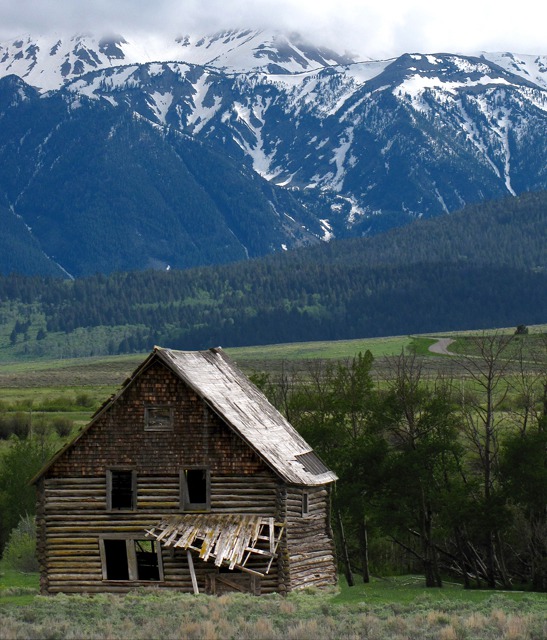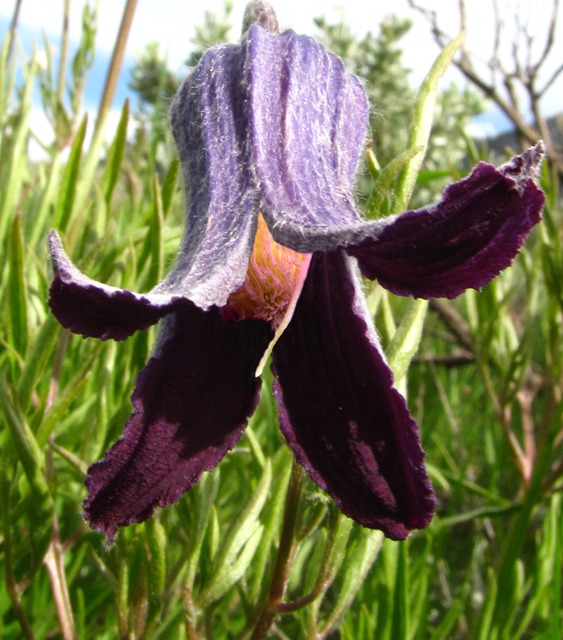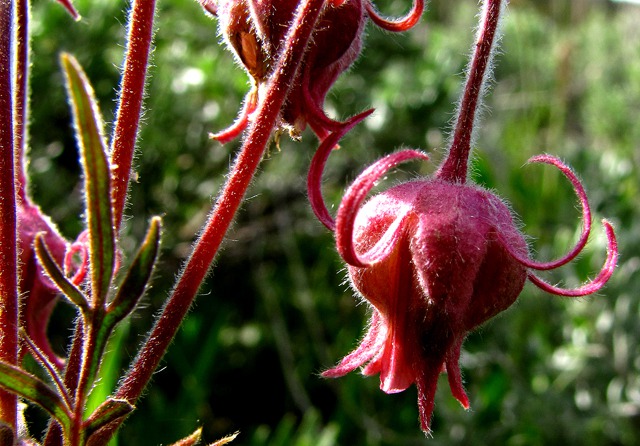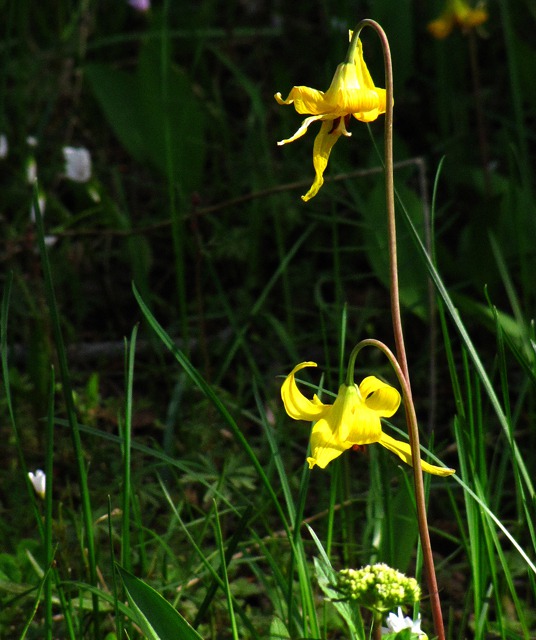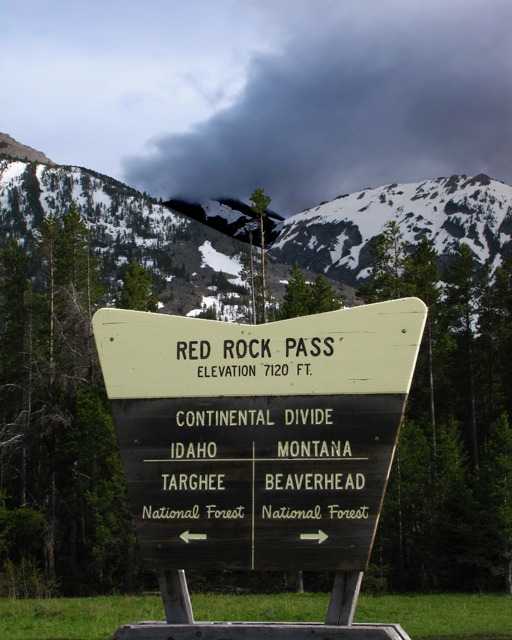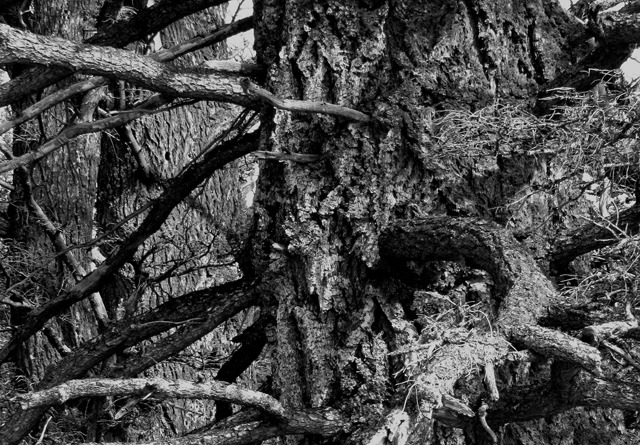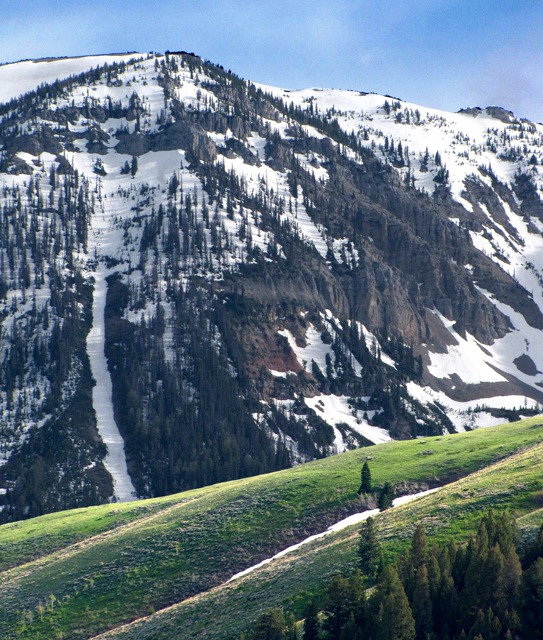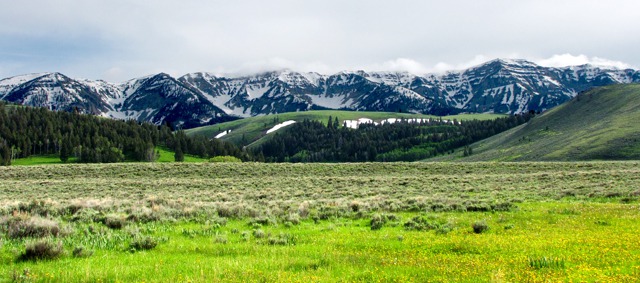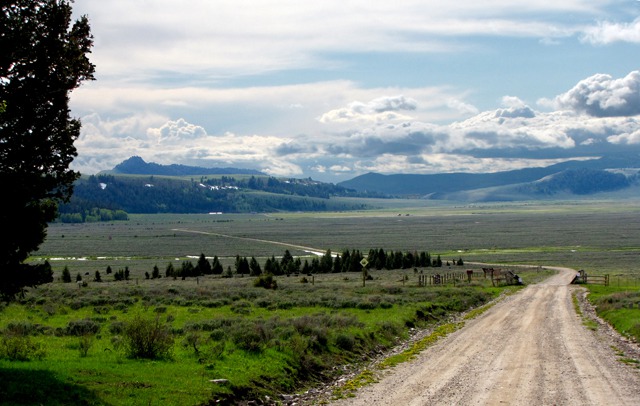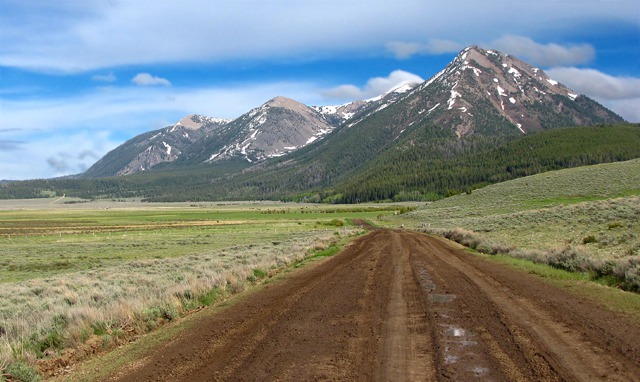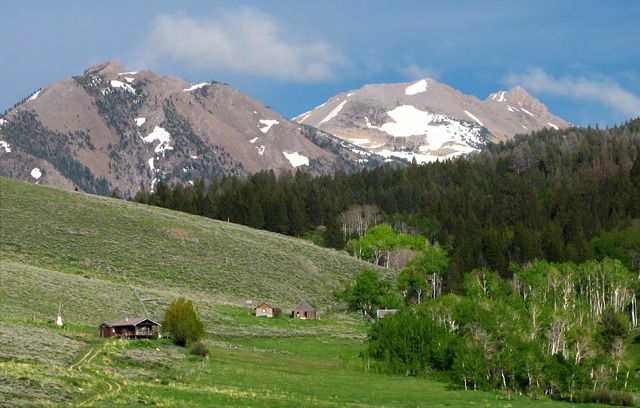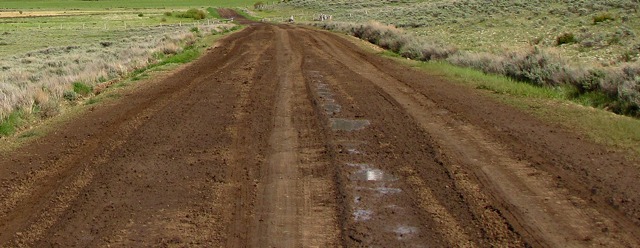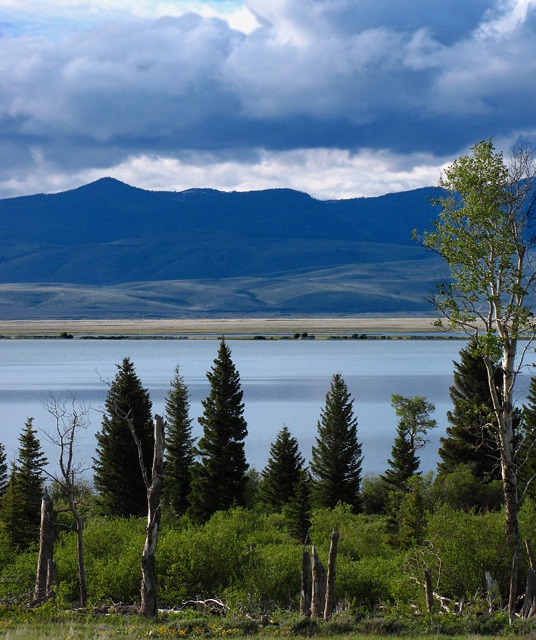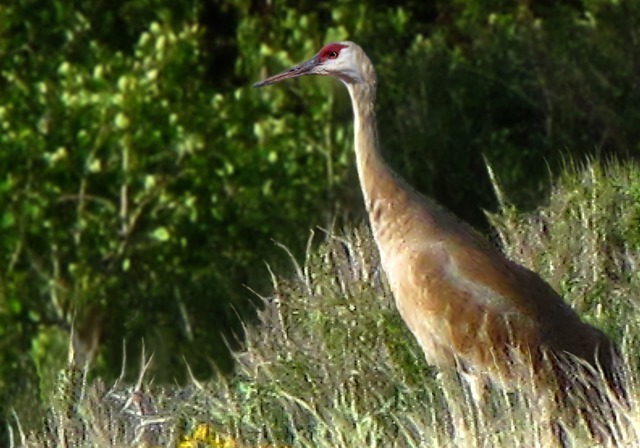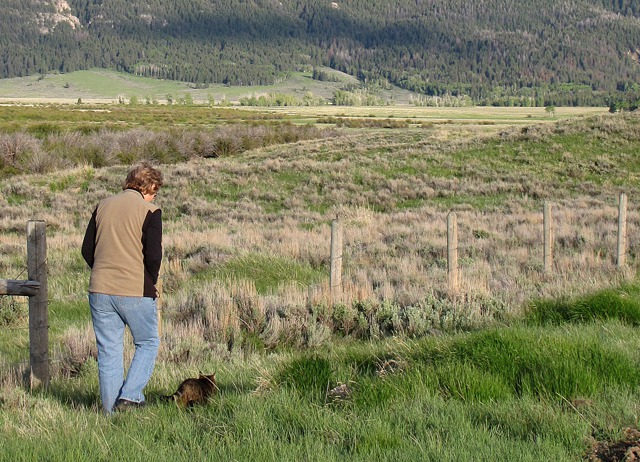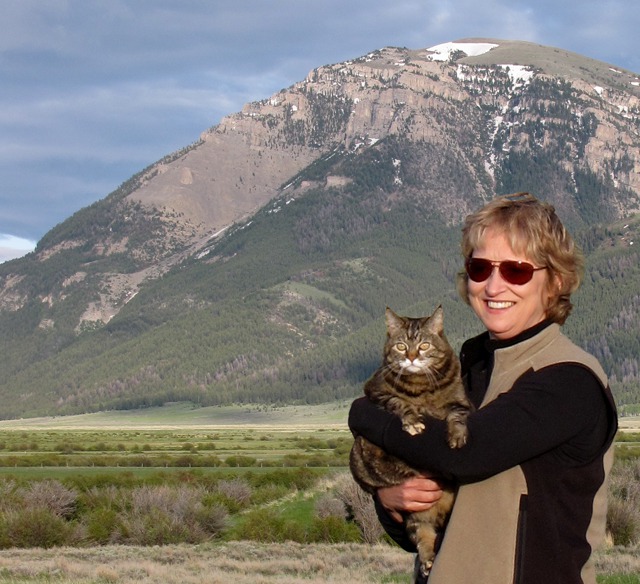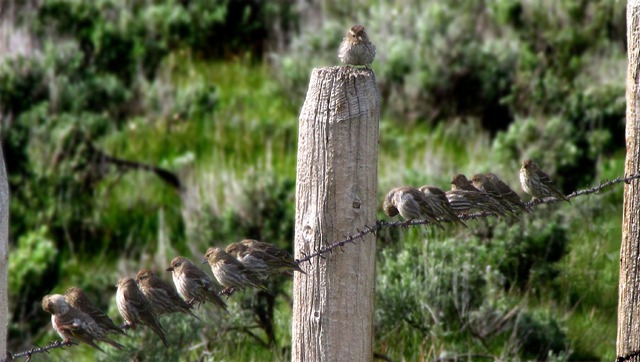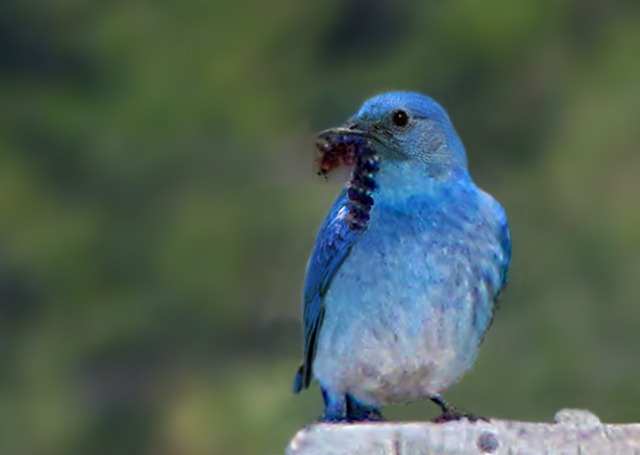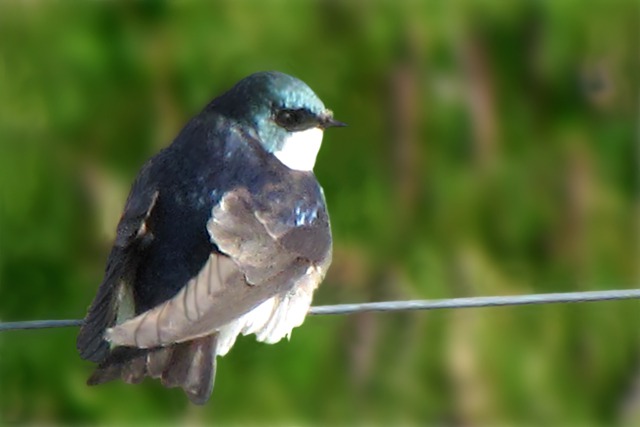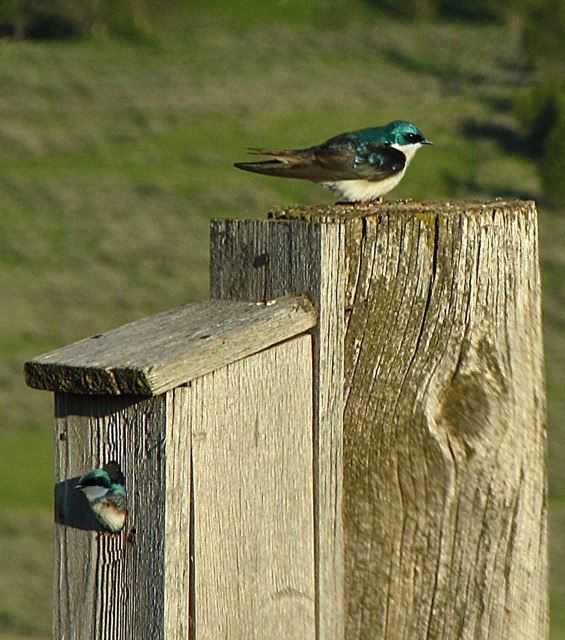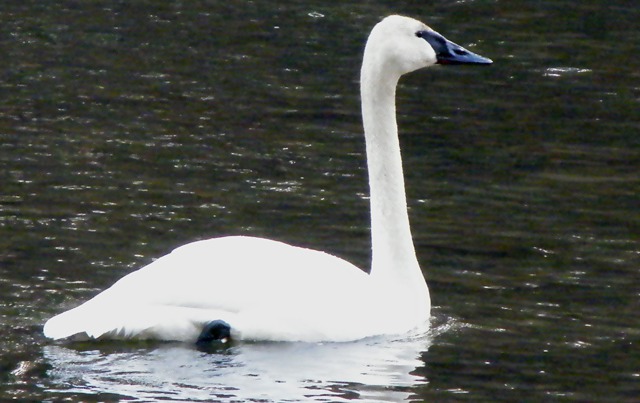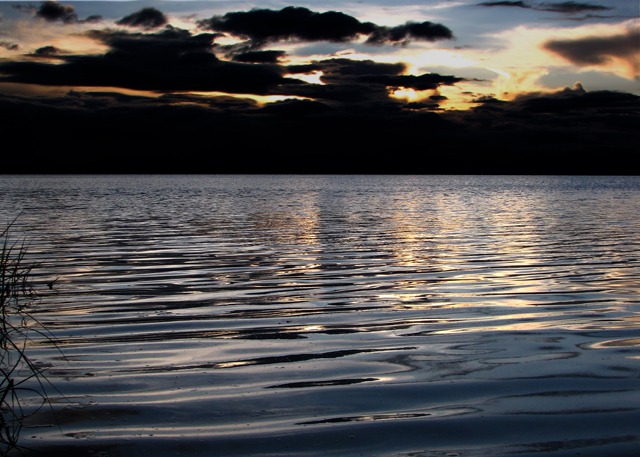A few miles into Idaho, we turned west again toward Staley Springs on the west shore of Henry's Lake. Now the road was gravel, muddy and rutted. The slopes of Saddle Mountain along Duck Creek were another meadow of late spring, early summer wildflowers. We just had to stop for a stretch and a picture-taking session. These high altitude sage brush meadows, tangy with the smell of sage, are beautiful examples of biodiversity. And the kitty loves the smells!
Sagebrush Ecology, by Louise: Each sage brush bush creates a miniature ecosystem as the snow gathers in drifts around each one. This means extra water at the base of the bushes. When the summer sun beats down and the temperatures climb to one hundred degrees, all manner of creatures seek out the shade of sage. So don't stick your hand or foot under the bush -- rattlesnakes live here, too!
A little further along we found more glacier lilies at the edge of the woods.
Off to the north from the roadside flower garden we could see iconic Sawtell Peak (9,875 feet) on the Caribou-Targhee National Forest with its communication equipment cap.An abrupt right turn sent us into the narrows of Red Rock Pass between the southern end of the Gravelly Range and the northern edge of the Centennial Range. We crossed the Continental Divide again and were back in Montana on the Beaverhead National forest.
As we slid and mucked along, we could see Upper and Lower Red Rock Lakes in the Centennial Valley ahead. Red Rock Mountain, Sawtell Peak, Mt Jefferson, Nemesis Mountain, and Taylor Mountain formed the timbered and snow-covered wall to our south -- all dark, north-facing slopes heavy with shade and water. This water is vital for the Wildlife Refuge we're visiting today.
According to the Refuge website (http://www.fws.gov/redrocks/), this road shown above was a stagecoach route from 1898 to 1917. Tourists traveled from the railroad terminus at Monida, now on I-15 south of Dillon, to West Yellowstone. In 1917, the stage was replaced by touring cars. I can't imagine how rough that ride must have been! Very intrepid tourists, those early visitors.
The website went on to say, "Red Rock Lakes NWR is primarily a high-elevation mountain wetland-riparian area. Red Rock Creek flows through the upper end of the Centennial Valley, creating the Upper Red Rock Lake, River Marsh and Lower Red Rock Lake marshlands. Red Rock Creek is near the headwaters of the Missouri River. These wetlands provide secluded habitat for the trumpeter swan, white-faced ibis, and Shiras moose.
The Refuge includes subirrigated meadows or "fens," grasslands, and forest as well. This minimally-altered natural diversity provides habitat for sandhill cranes, curlews, peregrine falcons, eagles, numerous hawks and owls, badgers, wolverines, bears, and wolves (in the backcountry), native fish such as Arctic grayling and westslope cutthroat trout, moose, and pronghorn antelope.
Much of what is now the Refuge was homesteaded at the turn of the twentieth century, but Refuge management has restored much of the naturalness to the area. Red Rock Lakes has the distinction of being designated a National Natural Landmark, as well as becoming one of the few marshland Wilderness Areas in the country.
Songbirds were everywhere, and there were bluebird nesting boxes along the road, some of which were occupied by tree swallows.
From the Website:
The Centennial Valley was well known to the Shoshone-Bannock, the Nez Perce, and other nomadic tribes as a favored travel route between the headwaters of the Big Hole River and the Yellowstone country. The wide stretches of uninterrupted native grasslands provided grazing bison with ample feed and served as their traditional summer range.
Settlement by Euroamericans did not occur until 1876. With settlement, herds of livestock were driven into the valley and homesteads sprang up in scattered locations. In the early days, market hunting for waterfowl and big game brought some revenue to local residents, but most settlers concentrated on livestock and sporadic lumbering.
The long winters, great distances to market, and small land parcels combined to make subsistence difficult. Few survived the depression of the 1930s. Red Rock Lakes NWR invites you to view and enjoy the nearby historic buildings and artifacts. Please be advised, however, that removal of any historical materials from Refuge property is prohibited."
The highlight of this Refuge is the trumpter swan. Heavily hunted by early settlers, they have been rescued from near extinction in the Greater Yellowstone Ecosystem (down 69 birds in 1932) to a population of over 500 in recent years. These birds are joined each winter by an additional 4000 trumpeters from Canada to form the Rocky Mountain population of trumpeter swans.
These largest of all North American waterfowl measure up to four feet, weigh between 20 to 30 pounds, and have a wingspan of up to eight feet. The swans must remain near open water to obtain their preferred diet of aquatic plants.
Their staple diet includes: waterweed, pondweed, water milfoil, and duck potato. A mature adult will consume up to 20 pounds of wet herbage each day! They also feed occasionally on grain, seeds, freshwater invertebrates, snails, and worms.
The continued existence of trumpeter swans in the Yellowstone Region depends in a large part upon the willingness of people to forego development in important swan habitat.
Trumpeter swans are extremely sensitive to many human activities and development in or near their habitats. Only a limited amount of suitable habitat exists in the region that is used regularly by trumpeters for breeding and wintering activities.
When these areas are disturbed by inappropriate recreational activities, summer home development, or through improper logging or road building practices, the birds will abandon these habitats.
Since most of the suitable swan habitat in the region is already occupied, the displaced birds have great difficulty finding new areas.
Winter habitat is especially critical and limiting. Few water areas in the region supply this type of habitat and once lost, cannot be replaced. Disturbance by winter recreationists which forces birds off these areas or human-caused changes in the lakes and streams which allow them to freeze over, places the trumpeters in danger of starvation.
We were lucky enough to see a pair of swans with a cygnet swimming of the far, far end of the lake, unfortunately well out of camera range. On this windy, cold day only a few devoted birdwatchers were out, sharing the thrill of seeing these birds.
As the sun set, we turned back over Red Rock Pass, renewed by our day in the deep wilds, sharing our humanity with the other sentient beings on Earth with a simple, careful visit to their home.
Louise with Photos by Brian
Text and Photos copyright -- Goin Mobyle LLC, 2009


